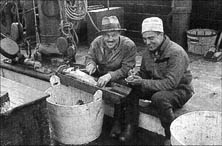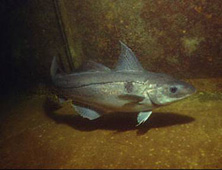Haddock (Melanogrammus aeglefinus)
- Haddock stocks are rebuilding and overfishing is no longer occurring.
- The most effective measures used to manage haddock fisheries have been closed areas, days-at-sea restrictions, and increased minimum trawl mesh size.
- Haddock is a great source of low-fat protein and is high in magnesium and selenium. For more on nutrition, see Nutrition Facts. (USDA)
- A little over 20% of the haddock consumed in the U.S. came from domestic fisheries in 2007. The remainder was imported. In 2007, the U.S. imported over 15 million pounds of fresh haddock, all from Canada, and almost 12 million pounds of frozen haddock, mainly from Norway.
|
 |
 |
 |
 |
| Nutrition Facts |
| Servings 1 |
| Serving Weight
100 g |
 |
| Amount Per Serving |
 |
| Calories 87 |
 |
| Total Fat |
0.72 g |
 |
| Total Saturated Fatty Acids |
0.13 g |
 |
| Carbohydrate |
0 g |
| Sugars |
0 g |
| Total Dietary
Fiber |
0 g |
 |
| Cholesterol |
57 mg |
 |
| Selenium |
30.2 mcg |
 |
| Sodium |
68 mg |
 |
| Protein |
18.91 g |
 |
|
 |
 Through the Atlantic Marine Aquaculture Center, a partnership between the University of New Hampshire and NOAA, researchers have found that Atlantic haddock is a good candidate for open ocean culture. For more information, see NOAA's Aquaculture Program.
Through the Atlantic Marine Aquaculture Center, a partnership between the University of New Hampshire and NOAA, researchers have found that Atlantic haddock is a good candidate for open ocean culture. For more information, see NOAA's Aquaculture Program.
|
 |
Did you know?
An average-sized female produces approximately 850,000 eggs, and larger females are capable of producing up to 3 million eggs annually.
After fertilization, haddock eggs become buoyant and rise to the surface where they drift with the ocean currents.
Haddock prefer bottom types of gravel, pebbles, clay, and smooth hard sand, all of which more common on Georges Bank, so haddock are more abundant there than in the Gulf of Maine.
|
|
| |
 |
|
William Herrington (left) determining the maturity stage of a haddock in 1935. Herrington was the first haddock biologist hired by the bureau of commercial fisheries, later renamed to the National Marine Fisheries Service.
|
 |
|
Haddock is closely related to the cod but can be distinguished by the black "thumbprint" found on each side of its body.
|
|
Sustainability Status
Biomass: The 2007 Georges Bank biomass estimate is about twice the level of the biomass needed to support maximum sustainable yield (BMSY). The amount of haddock born on Georges Bank in 2003 was the largest on record, and as a result, the stock is rebuilt. As of 2007, the Gulf of Maine biomass is 99% of BMSY and expected to exceed BMSY by 2009.
Overfishing: No
Overfished: Yes*
Fishing and habitat: Haddock are targeted with otter trawls, gillnets, and longlines. Gillnets and longlines have very little or no impact on habitat. Otter trawls may impact habitat, depending on where they are used. For more information, see Fisheries Gear.
Bycatch: Minimum trawl mesh sizes are currently the largest in the history of the Northeast groundfish fishery. The larger mesh nets catch fewer small fish, and this directly reduces bycatch.
Aquaculture: There is currently no aquaculture production of haddock in the U.S., but research is being conducted on aquaculture of haddock and cod.
*The Georges Bank stock is currently considered overfished. However, based on the latest stock assessment results published in September 2008, the status will change to not overfished and rebuilt if the results are finalized. The Gulf of Maine stock is currently considered overfished. However, based on the latest stock assessment results, the status will change to not overfished if the results are finalized.
|
Science and Management
The two major stocks of haddock in U.S. waters are located on Georges Bank and in the Gulf of Maine; both support year-round commercial fisheries. These stocks are managed as part of the Northeast Multispecies fishery, a complex of 15 groundfish species, by the New England Fishery Management Council under the Northeast Multispecies Fishery Management Plan (FMP). Originally implemented in 1985, this FMP currently manages the multispecies fishery through effort limitations, closed areas, trip limits, gear restrictions, minimum size restrictions, a total allowable catch, and a bycatch cap.
Since 1994, direct fishing effort controls have been in place under Amendments 5 and 7, including a moratorium on permits and days-at-sea restrictions. Amendment 9 established initial biomass rebuilding targets and a harvest control rule that specified target fishing mortality rates. In May 2004, Amendment 13 was implemented to end overfishing on all groundfish stocks and rebuild all groundfish stocks that are overfished, including haddock. The overall goal of this amendment is to reduce fishing mortality to rebuild depleted groundfish stocks to target biomasses. This Amendment established an adaptive rebuilding strategy for stocks of Georges Bank and Gulf of Maine haddock and set a target rebuilding date of 2014.
The Georges Bank haddock stock is also a transboundary resource, meaning the stock migrates across international boundaries. Therefore, management of a portion of the stock is coordinated with Canada. The Canadian fishery on Georges Bank is managed under an individual quota system. An informal quota sharing understanding between Canada and the U.S. was implemented in 2004 to share the harvest of the transboundary portion of the stock. This understanding includes total allowable catch quotas for each country as well as in-season monitoring of the U.S. catch of haddock on eastern Georges Bank.
Recreational landings of Georges Bank haddock are not significant, but recreational catches of Gulf of Maine haddock have increased in recent years and now make up 12 to 16 percent of total catches.
|
Life History and Habitat
Life history, including information on the habitat, growth, feeding, and reproduction of a species, is important because it affects how a fishery is managed. High reproductive potential in haddock means they may respond to management actions more rapidly than species that reproduce slowly and in small numbers.
- Geographic range: In both sides of the North Atlantic: in the western North Atlantic, they range from the Strait of Belle Isle, Newfoundland to Cape May, New Jersey. The highest concentrations of haddock off the U.S. coast are on Georges Bank and in the Gulf of Maine.
- Habitat: Haddock live in bottom habitats with a substrate of pebble gravel, broken ground, and sand areas between rocky patches. Haddock are most common from depths of 131 to 492 feet and temperatures less than 45 degrees Fahrenheit. Juveniles are found in shallower water on bank and shoal areas, and larger adults are associated with deeper water.
- Life span: The oldest recorded haddock in U.S. waters is a 17-year-old fish captured in 1980, but most live to age 3 to 7.
- Food: Haddock are bottom feeders with a diverse diet that includes gastropod and bivalve mollusks, polychaete worms, amphipods, crabs, shrimps, sea stars, sea urchins, sand dollars, brittle stars, and occasional fish eggs. Adults will sometimes consume small fishes, especially herring. Larvae and small juveniles swimming in the water column eat small crustaceans, primarily copepods and euphausiids, as well as polychaetes and small fishes.
- Growth rate: In the Gulf of Maine, juvenile haddock (less than 4 years) grow approximately 6 inches per year, slowing to 1 to 2 inches per year as adults. In general, American haddock grow faster than European haddock.
- Maximum size: Range in length from 1 foot to a maximum of about 3.3 feet. The largest haddock captured in U.S. waters weighed 30 pounds.
- Reaches reproductive maturity: Between the ages of 1 and 4
- Reproduction: Haddock have high reproductive potential - an average-sized female (22 inches) produces approximately 850,000 eggs, and larger females are capable of producing up to 3 million eggs annually. They are broadcast spawners, meaning that females release eggs in batches near the ocean bottom where they are fertilized by a courting male. Once fertilized, eggs become buoyant and rise to the surface water layer where they drift with ocean currents. Juvenile haddock remain near the surface for several months after hatching before settling to the bottom.
- Spawning season: Between January and June, peaking during February to early April on Georges Bank, the primary spawning area
- Spawning grounds: Spawning concentrations occur on eastern Georges Bank, to the east of Nantucket Shoals and along the Maine coast over rock, gravel, sand, or mud bottoms.
- Migrations: Adult haddock do not undertake long migrations but move seasonally in the western Gulf of Maine, the Great South Channel, and on the northeast peak of Georges Bank. Adults move into shallower waters in spring to spawn.
- Predators: Predators of juveniles include elasmobranchs (spiny dogfish and skates) and many groundfish species (cod, pollock, cusk, white hake, red hake, silver hake, goosefish, halibut, and sea raven). Gray seals also prey on haddock.
- Commercial or recreational interest: Both
- Distinguishing characteristics: Haddock are closely related to the cod but distinguished by the black "thumbprint" found on each side of its body.
|
Role in the Ecosystem
|
Additional Information
Market name: Haddock
Vernacular name: Scrod haddock
|
Biomass
 Biomass refers to the amount of haddock in the ocean. Scientists cannot collect and weigh every single fish to determine biomass, so they use models to estimate it instead. These biomass estimates can help determine if a stock is being fished too heavily or if it may be able to tolerate more fishing pressure. Managers can then make appropriate changes in the regulations of the fishery.
Biomass refers to the amount of haddock in the ocean. Scientists cannot collect and weigh every single fish to determine biomass, so they use models to estimate it instead. These biomass estimates can help determine if a stock is being fished too heavily or if it may be able to tolerate more fishing pressure. Managers can then make appropriate changes in the regulations of the fishery.
As a result of persistent overfishing in the 1980s, Georges Bank spawning biomass declined from 71,230 metric tons (157 million pounds) in 1980 to only 14,900 metric tons (33 million pounds) in 1993. Since 1994, fishery management measures have been implemented to decrease fishing mortality, and spawning biomass has increased substantially as a result of management measures, and an exceptionally large 2003 year class (fish in the stock born in the same year). The Georges Bank haddock stock is no longer in an overfished condition since spawning biomass in 2007 was about double the re-estimated reference point.
Nearly a decade of poor recruitment combined with persistent overfishing caused the Gulf of Maine spawning biomass to decline from a high of 15,000 metric tons in the early 1980s to a low of 550 metric tons by 1989. Several strong recruitment events along with low fishing mortality produced spawning biomasses in the early 2000 period that were nearly equivalent to those observed during the early 1980s. The Gulf of Maine stock is no longer considered overfished. By 2009, the Gulf of Maine stock is expected to exceed the biomass levels needed to support maximum sustainable yield.
Note: Spawning biomass, the total weight of sexually mature fish in the population, is presented in the graphs.
Landings
 Landings refer to the amount of catch that is brought to land. Total commercial haddock landings (U.S. and Canada) from the Georges Bank and Gulf of Maine stocks increased to 15,513 metric tons in 2007 from landings of 22,050 metric tons (48.6 million pounds) in 2005. The 2005 haddock catch was the highest total catch since 1983 (19,606 metric tons/43.2 million pounds) and almost 9 times greater than the record low of 2,469 metric tons (5.4 million pounds) in 1995. Landings have generally increased each year since 1995 as the stock has been rebuilding under restrictive management measures. Current landings are about half the long-term potential yield of the combined Georges Bank and Gulf of Maine haddock stocks. Landings refer to the amount of catch that is brought to land. Total commercial haddock landings (U.S. and Canada) from the Georges Bank and Gulf of Maine stocks increased to 15,513 metric tons in 2007 from landings of 22,050 metric tons (48.6 million pounds) in 2005. The 2005 haddock catch was the highest total catch since 1983 (19,606 metric tons/43.2 million pounds) and almost 9 times greater than the record low of 2,469 metric tons (5.4 million pounds) in 1995. Landings have generally increased each year since 1995 as the stock has been rebuilding under restrictive management measures. Current landings are about half the long-term potential yield of the combined Georges Bank and Gulf of Maine haddock stocks.
Note: Both U.S. and Canadian landings are shown in the graph; however, Canadian landings in the Gulf of Maine end after 1986. The Gulf of Maine fishery is has been largely dominated by the United States. There were two periods of significant Canadian landings, 1965-1968 and 1978-1986.
Biomass and Landings
 Are landings and biomass related? Landings are dependent on biomass, management measures in the fishery, and fishing effort. Are landings and biomass related? Landings are dependent on biomass, management measures in the fishery, and fishing effort.
Data sources:
Biomass and landings from the Northeast Fisheries Science Center Assessment of 19 Northeast Groundfish Stocks through 2007
|
Important Dates
1960s – Georges Bank haddock stock collapses due to a succession of poor recruiting year classes and heavy removals by distant water fleets
Late 1960s-early 1970s – Georges Bank spawning stock remains at very low levels and recruiting year classes remain very poor
1975 – Extremely large year class in Georges Bank; population increases substantially
1982 – Interim Groundfish Fishery Management Plan implemented
1984 – The "Hague Line" is implemented, establishing the joint management of eastern Georges Bank haddock between the U.S. and Canada
1985 – Northeast Multispecies Fishery Management Plan adopted
1991 – Georges Bank haddock, a mainstay of the New England groundfishery, are depleted to the lowest total levels ever recorded
1993 – Mature Georges Bank haddock at their lowest
1990s – Conservation measures for Georges Bank haddock enacted by U.S. and Canada; stock begins to rebound
1994 – Amendment 5 adopted, creating limited entry permits and limiting the number of days fishermen could fish
1995 – Lowest recorded catch of Georges Bank haddock
2003 – Spawning haddock on Georges Bank produce the largest incoming group of young fish in 40 years, and perhaps the largest on record for the stock
2004 – Quota sharing agreement between Canada and the U.S. implemented for eastern Georges Bank haddock; includes total allowable catch (TAC) allocations and in-season monitoring of the haddock catch
2004 – Amendment 13 implements requirements for formal rebuilding programs; also reduces number of days-at-sea allocated to each permit and adopts measures to protect essential fish habitat
2004 – Georges Bank total commercial catch of 17,600 metric tons (38.8 million pounds) is over 7 times larger than lowest catch in 1995
2008 – Use of the "Ruhle trawl", commonly known as the eliminator trawl by the Northeast commercial groundfish fishing industry, is approved; it is intended to help conserve and restore depleted groundfish resources, such as cod and flounders, while allowing vessels to target haddock and other healthier stocks that live in the same area
|
Notes and Links
General Information:
NOAA Northeast Fisheries Science Center Status of Fishery Resources off the Northeastern U.S. - Haddock
NOAA Technical Memorandum, Essential Fish Habitat Source Document: Haddock, Melanogrammus aeglefinus, Life History and Habitat Characteristics, Second Edition
Fishery Management:
New England Fishery Management Council Northeast Multispecies (Groundfish) Fishery Management Plan and information
Stock Assessments:
Northeast Fisheries Science Center Assessment of 19 Northeast Groundfish Stocks through 2007
|
| |
|



